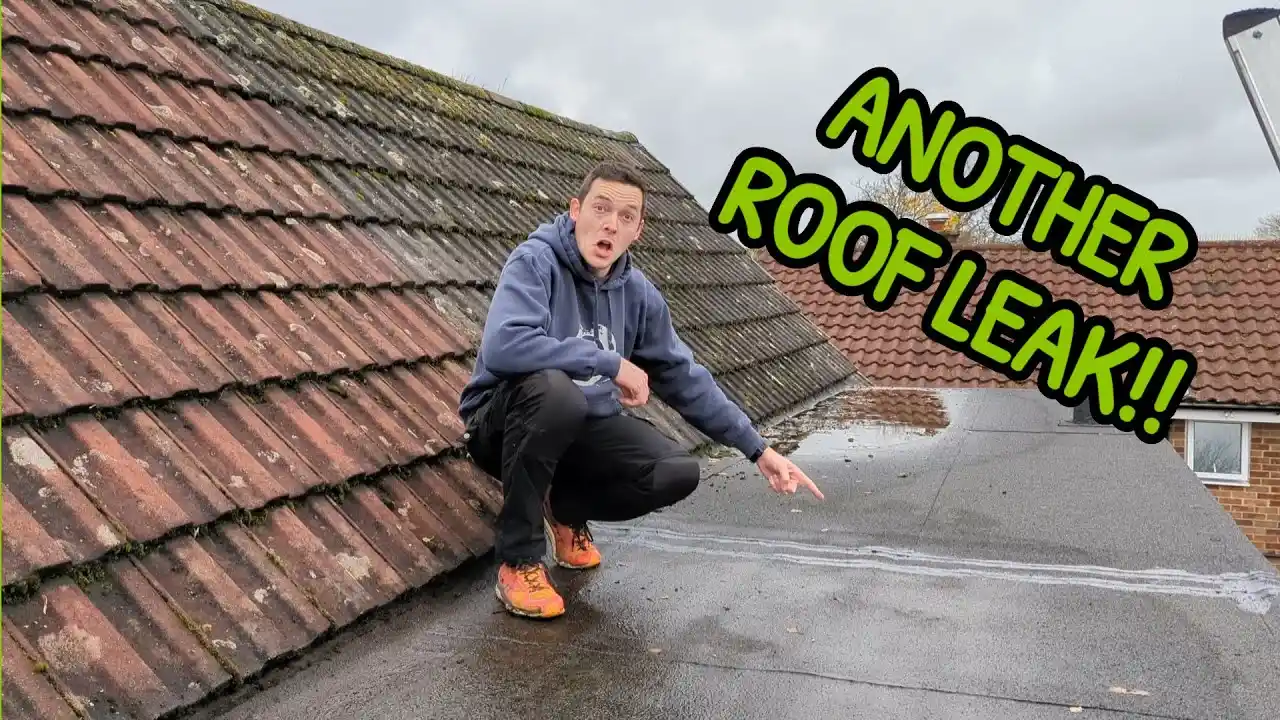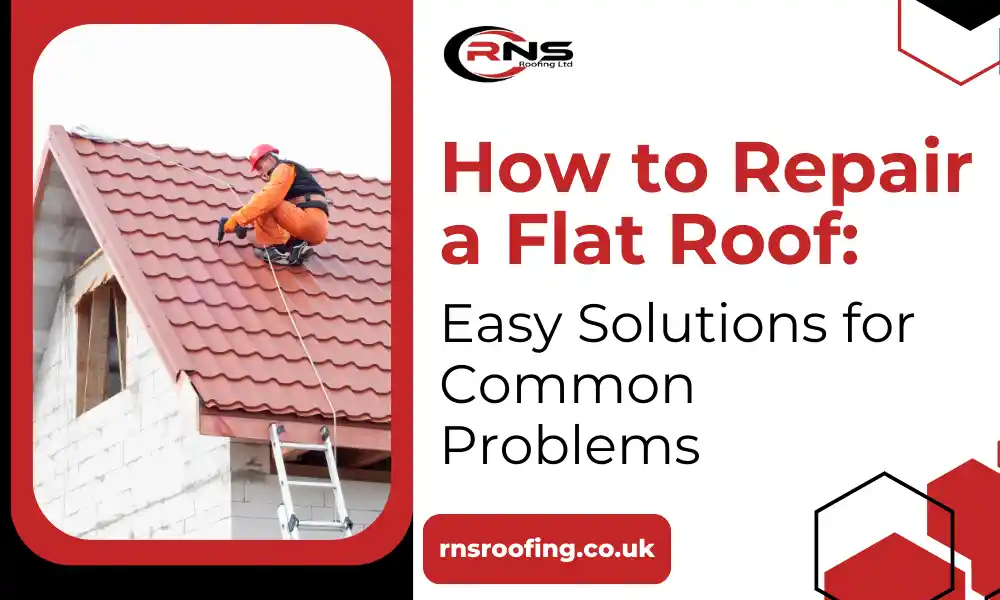Flat roofs are popular due to their sleek design and practicality, but they can wear down over time. Leaks, cracks, or blisters may appear, requiring a quick repair to avoid further damage. This easy-to-follow guide will walk you through how to repair a flat roof and protect it from future issues.
Inspect Your Flat Roof for Damage
The first step in any flat roof repair is carrying out a thorough inspection. Identifying the problem areas helps you assess the damage and decide what repairs are needed.
- Common Signs of Damage:
- Cracks in the roof’s surface
- Blisters or bubbles in the membrane
- Water pooling (also known as ponding)
- Gaps around the roof edges or flashing
It’s a good idea to check your roof regularly, especially after bad weather.
How to Identify and Fix a Leaking Flat Roof
It is possible to find a leaking flat roof repair yourself from inside your property, especially if it is a small leak. Start by measuring the distance from the spot where you can see the leak to the nearest two walls, and then use those measurements to locate the leak on the outside of the rooftop itself.
Note that most flat rooftops have a slight slope to allow for runoff, so you should start trying to locate the leak from the possible point of entrance on the roof since the water will naturally run downhill.
Of course, you should also start by looking for rips, punctures, worn spots, loose or popping screws, separations in the seams, or other issues with your flat roof membrane.
If you do all of this and still can’t locate any leaks, call a professional flat roof leak repair, contractor to find the leak and repair them as soon as possible. Having the materials and tools to repair flat roof leaks is also essential. At the very least, you’ll need replacement materials and essential tools on hand, so if that seems overly complex, call a professional to take care of your roof damage issues.
Top Reasons Your Roof May Be Leaking

There are some reasons why your roof may spring a leak, or other roof damage may occur.
Natural disasters like hail storms, tornadoes, hurricanes, electrical storms, floods, wind damage storms, and related severe weather often damage commercial roofing.
Suppose you experience one of these natural disasters. In that case, inspecting your roof and assessing any damage is something you should prioritize during the aftermath, even if you do not notice any leaks immediately.
How to Repair a Flat Roof: Effective Techniques for Long-Lasting Results
Clean the Roof Before Repairing
Before making any repairs, ensure the roof surface is clean. Debris, dirt, or moss can interfere with the repair materials and prevent them from sticking correctly.
- How to Clean a Flat Roof:
- Sweep away loose dirt, leaves, and debris with a broom
- Scrub moss or algae off using a stiff brush and mild detergent
- Rinse and dry the roof thoroughly
A clean, dry surface ensures that your repairs will hold adequately and last longer.
Locate and Mark the Damaged Areas
After cleaning the roof, closely examine the damaged sections you identified earlier. This will help you focus on the areas that need the most attention.
- Minor Cracks and Holes:
These are often easy to fix with sealant or a patch kit.
- More significant Leaks or Major Damage:
If the damage is more significant, you may need to replace part of the roofing material.
Marking these areas will make the repair process smoother and more organized.
Patch the Roof with the Right Materials
The type of repair you carry out will depend on the damage. Here are the most common fixes:
- For Small Cracks or Leaks:
- Apply high-quality roofing cement or sealant
- Use a self-adhesive patch for added protection
- Smooth down the edges and press firmly
- For Larger Damage:
- Remove the damaged roofing material around the affected area
- Apply a new waterproof membrane or roofing felt
- Ensure the material is cut to size and properly sealed
Tip: Always follow the manufacturer’s instructions on the repair materials to ensure a solid, weatherproof fix.
Seal and Reinforce the Repaired Area
Once the patch is in place, it’s important to seal the area to prevent future leaks. For the best results, use a roofing sealant compatible with your roof material.
- Generously apply the sealant over the patch and surrounding area
- Allow the first layer to dry thoroughly before applying additional coats
Adding multiple layers of sealant will reinforce the repaired area and provide better protection from the elements.
Prevent Future Roof Problems
Maintenance is key to extending the life of your flat roof repairs. Regular inspections and upkeep can help you spot potential problems early and avoid costly repairs.
- Clean the Roof Regularly:
Clear away debris, leaves, and standing water to prevent damage.
- Check Flashing and Roof Edges:
Ensure the edges and joints around chimneys, skylights, and vents are sealed tightly.
- Inspect After Bad Weather:
Look for cracks, leaks, or pooling water after heavy rain or snow.
When Should You Call a Professional?
While some flat roof repairs are easy enough to handle on your own, there are times when it’s best to get professional help:
- If the damage is extensive:
If there are widespread leaks or structural issues, a roofing expert can provide a more durable solution.
- If you’re unsure about the repairs:
A qualified roofer can diagnose and repair the problem efficiently, saving you time and preventing further issues.
Conclusion
Repairing a flat roof is a DIY project that can be tackled with the right tools, materials, and a little know-how. By following these steps, you can effectively address minor damage and prolong the lifespan of your roof. If you encounter significant issues or are unsure about the repair process, it’s always best to consult a professional roofer.
FAQs
1. How much does it cost to repair a flat roof?
The cost of repairing a flat roof depends on the extent of the damage and the materials required. Small DIY repairs can be relatively inexpensive, while professional repairs for significant damage can range from a few hundred to several thousand pounds, depending on the scope.
2. What is the most common cause of flat roof leaks?
The most common causes of flat roof leaks are poor drainage (leading to water pooling), cracks in the roofing membrane, damaged flashing, and improper installation of the roof materials.
3. Can I repair a flat roof in wet weather?
It’s best to wait for dry weather to repair your flat roof. The surface must be clean and completely dry to ensure the patch or sealant adheres appropriately. Wet conditions can cause repairs to fail or materials to degrade more quickly.
4. How do I know if my flat roof needs repairing?
Common signs that your flat roof needs repair include water leaks, cracks in the roofing material, pooling water (ponding), blisters or bubbles in the membrane, and damaged flashing around the roof edges or vents.

